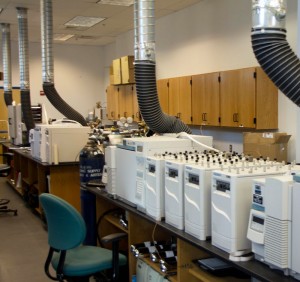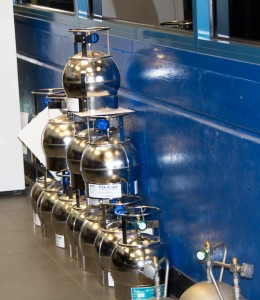CEMRC first began analysis of samples for the Confirmatory VOCs Monitoring Plan in April 2004, using analysts from the Environmental Chemistry (EC) Group. The Organic Chemistry program was then established and successfully audited by the NWP QA group prior to acceptance of actual samples and is audited yearly since 2004.
The original VOC’s laboratory was set up in a small room in the science laboratory wing at CEMRC and only included the equipment necessary for Confirmatory VOCs analysis. Later the Department of Energy (DOE) requested that CEMRC expand its capabilities to prepare for the analysis of headspace gas (HSG) samples collected from waste drums required under the WIPP Permit. In preparation for this expansion of scope, CEMRC purchased a HSG analysis system consisting of a 6890/5973N Agilent GC/MS with a loop injection system and three Entech 7032 Autosamplers installed in series were purchased from Entech Instruments, Inc. Also included in this purchase was an Entech 3100A oven-based canister cleaning system, an Entech 4600 Dynamic Diluter for automatic preparation of VOCs calibration standards, and fifty 400 mL Silonite-coated mini-canisters with Nupro valves and attached pressure gauges.
Funding was obtained in mid-2005 through a DOE baseline change request to remodel the old CEMRC garage into a functional GC/MS Laboratory. The design for the remodel was completed in late 2005, and construction began in January 2006. Construction was completed in April 2006 and the OC Group moved into the new laboratory.
The Volatile Organic Compound Monitoring expanded from 353 samples in 2005 to 430 samples in 2006. Analysis of closed room samples for VOCs, hydrogen, and methane began in 2007 as well and continues to the present. In 2007, CEMRC analyzed a total of 749 samples for VOCs and 182 samples for hydrogen and methane. In 2008, a total of 608 samples were analyzed for VOCs and 254 samples were analyzed for hydrogen and methane, while in 2009, a total of 571 samples were analyzed for VOCs and 339 samples were analyzed for hydrogen and methane.
Although CEMRC performed well on the DOE audit for the headspace gas analysis project, a decision was made not to submit these samples for analysis at CEMRC. However, some equipment obtained for this project is currently being used for analysis of closed room samples for VOCs and percent levels of hydrogen and methane.

